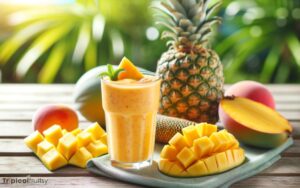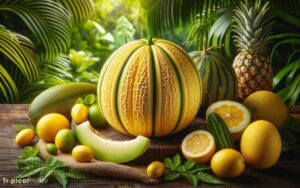Why Are Tropical Fruits So Sweet? Explore!
Tropical fruits are notably sweeter because of the high levels of sunlight in their native environments which promotes increased sugar production through photosynthesis.
Additionally, the natural selection for sweeter fruits, which are more attractive to animals for seed dispersal, and selective breeding for human consumption have further amplified their sugar content.
The sweetness of tropical fruits is due to several factors:
Examples of sweet tropical fruits include mangos, pineapples, and papayas.
Sweet tropical fruits result from nature’s careful orchestration to ensure survival through seed dispersal and human cultivation preferences.

Key Takeaway
Factors Influencing Fruit Sweetness in Tropical Fruits
| Factor | Explanation | Example Fruits |
|---|---|---|
| Abundant Sunlight | More sunlight in the tropics enhances photosynthesis, leading to higher sugar production. | Mango, Banana |
| Evolutionary Role | Sweetness attracts animals for consumption, which helps in spreading seeds. | Papaya, Guava |
| Rapid Ripening | Warmer temperatures in the tropics accelerate fruit ripening, increasing natural sugars. | Pineapple, Lychee |
| Selective Breeding | Humans have cultivated fruit plants to yield sweeter varieties to satisfy taste preferences. | Watermelon, Kiwi |
The Science of Sweetness
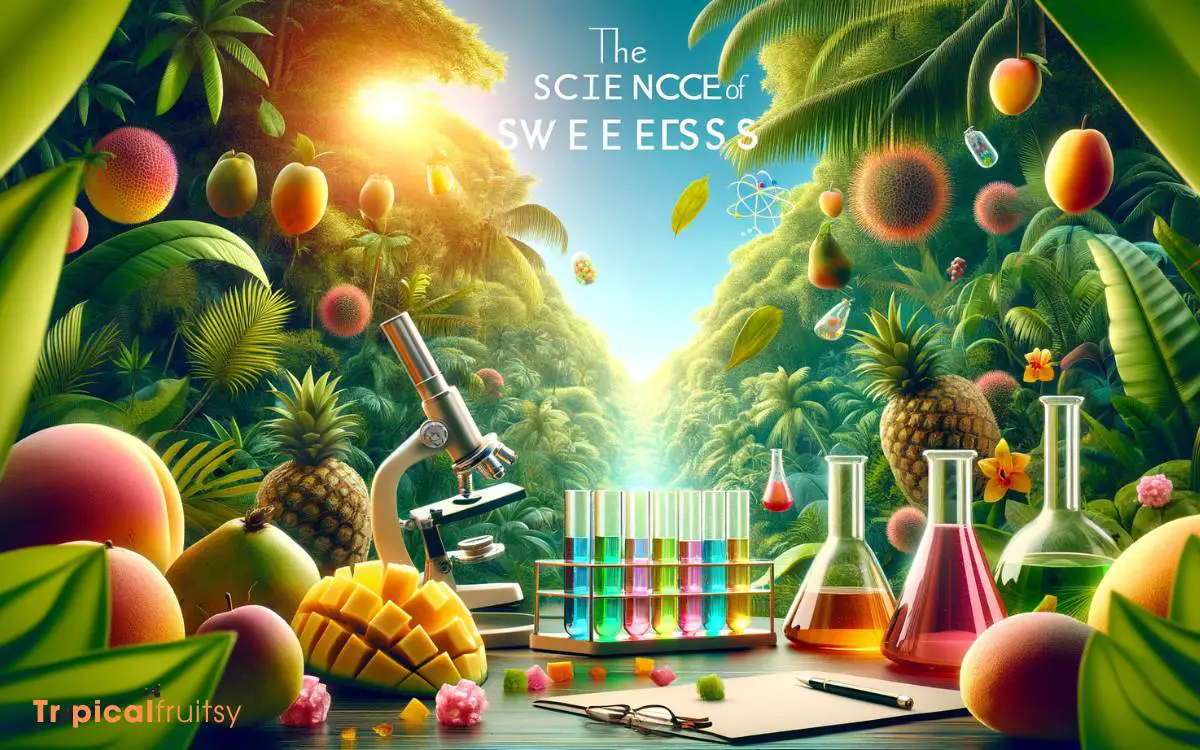
The sweetness of tropical fruits can be attributed to the natural sugars they accumulate during their maturation process, which serves both to attract animals for seed dispersal and to provide a quick energy source for consumers.
These sugars, primarily fructose, glucose, and sucrose, are the result of complex biochemical pathways involving photosynthesis and the transformation of starch reserves.
In the tropics, where intense sunlight and warm temperatures prevail, photosynthetic activity is maximized, thus enhancing sugar synthesis.
Furthermore, enzymatic reactions that convert starch to simple sugars are more active at higher temperatures, leading to the characteristic sweetness of tropical fruits.
This adaptive mechanism ensures that the fruits are desirable to frugivores, facilitating the spread of seeds, and simultaneously offering humans and other animals a flavorful and energetic food source.
Sunlight and Sugar Production
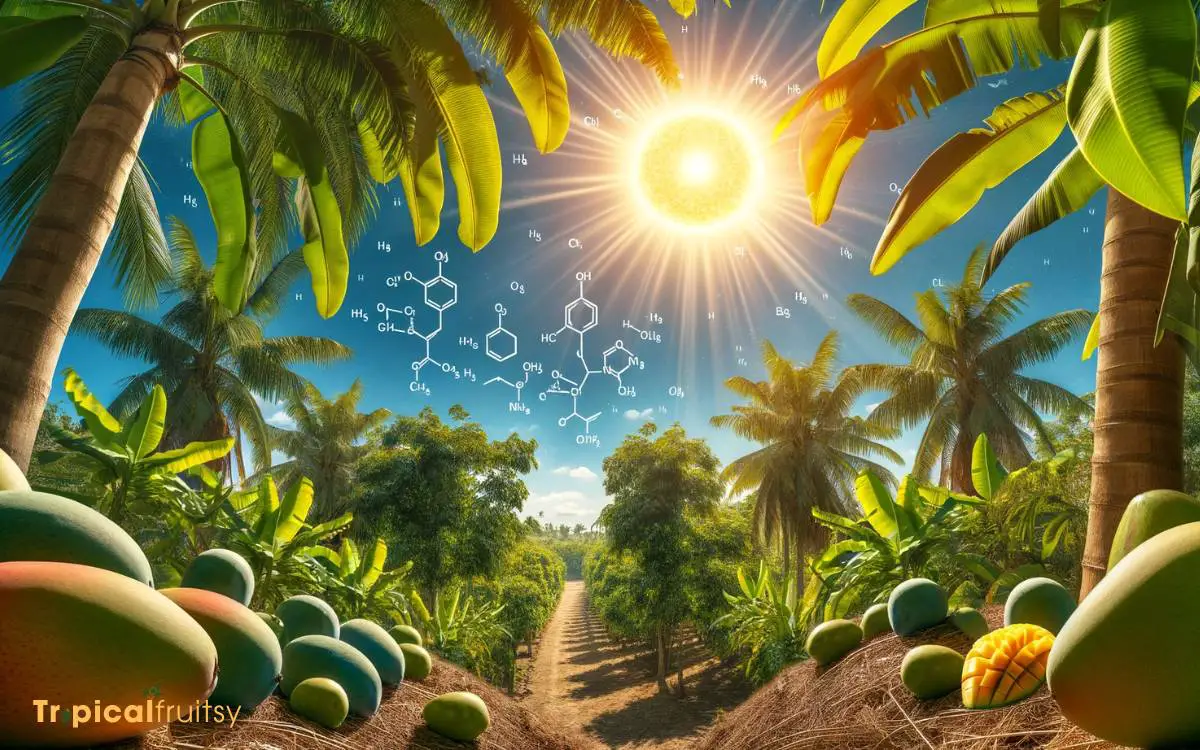
Tropical regions’ abundant sunlight plays a crucial role in the high sugar production of fruits by facilitating the rate of photosynthesis.
The intense solar exposure characteristic of these climates provides the energy necessary for plants to convert carbon dioxide and water into glucose and oxygen.
This biochemical process is central to fruit development, yielding higher sugar concentrations in tropical species.
Photosynthesis Efficiency:
- Enhanced by strong, direct sunlight
- Accelerates conversion of CO2 to sugars
- Results in sweeter fruit profiles
Solar Intensity:
- Greater in equatorial zones
- Promotes vigorous growth
- Boosts sugar accumulation in fruit
Day Length:
- Consistent year-round near the equator
- Supports uninterrupted photosynthetic activity
- Contributes to stable sugar production
Understanding this photosynthetic advantage sets the stage for exploring evolutionary traits for attractiveness in the next section.
Evolutionary Traits for Attractiveness
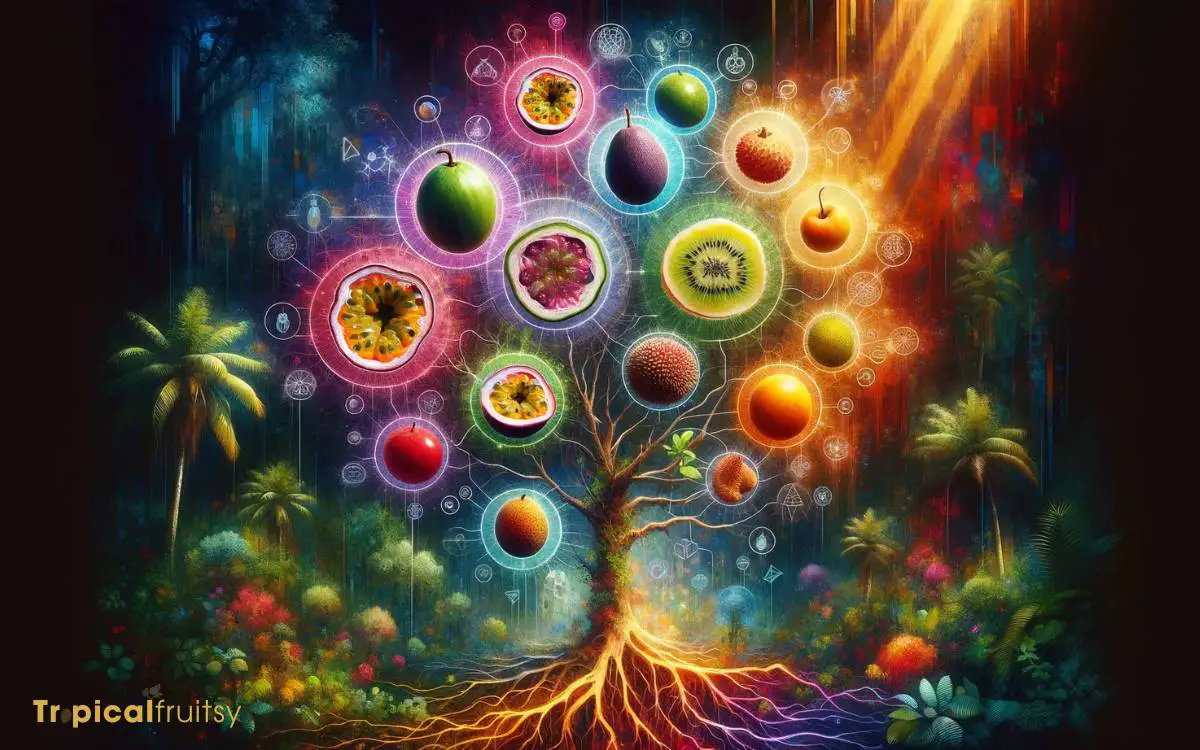
The heightened sweetness of tropical fruits is an evolutionary adaptation that serves as a critical pollinator attraction strategy, enhancing the likelihood of plant reproduction.
Additionally, the palatability of sweet fruits functions as an effective seed dispersal mechanism, enticing a variety of animals to consume the fruit and subsequently transport seeds to new locations.
This survival strategy, predicated on the allure of sweetness, ensures that plants can successfully propagate within their ecosystems, securing their genetic lineage.
Pollinator Attraction Strategy
One evolutionary trait that has significantly influenced the sweetness of tropical fruits is their development as a mechanism to attract pollinators effectively. This is a critical aspect of the reproductive strategy of many tropical plants.
Enhanced Sweetness:
- High Sugar Concentration: Acts as an olfactory signal to pollinators.
- Rich Nectar Production: Encourages longer visitation from pollinators, increasing the chances of cross-pollination.
- Bright Colors and Aromatic Scents: Serve as visual and olfactory cues that guide pollinators to the flowers.
These evolutionary traits have developed over millennia, fine-tuning the interaction between tropical plants and their pollinators. This intricate relationship is foundational to the perpetuation of these species.
The ensuing section will explore how these attractive characteristics also play a role in another vital process: the seed dispersal mechanism.
Seed Dispersal Mechanism
Many tropical fruits have evolved to possess sweet flavors and vibrant appearances, characteristics that are crucial for effective seed dispersal by attracting a variety of animal vectors.
These evolutionary traits serve as enticements for frugivorous animals, such as birds, bats, and primates, incentivizing them to consume the fruit and subsequently disperse the seeds through defecation or discard.
The high sugar content provides a dense energy source for these mobile dispersers, while the striking coloration of the fruit stands as a visual cue in dense foliage.
Moreover, the fruit’s palatability and nutritional value are often finely tuned to the dietary preferences of specific dispersers, thereby enhancing the probability of seed dissemination across suitable habitats, facilitating plant reproduction and genetic diversity.
Survival Through Sweetness
Tropical fruits’ distinct sweetness is not merely a gustatory delight but an evolutionary adaptation to ensure the survival of the species by maximizing the appeal to potential seed dispersers.
This biological strategy involves several intricate mechanisms:
Increased Fructose:
- Attracts frugivorous animals
- Triggers rapid energy release for consumers
- Enhances seed dispersal radius
Aromatic Compounds:
- Serve as olfactory signals to animals
- Chemical diversity creates species-specific attractants
- Facilitates pollinator fidelity and specialization
Vivid Coloration:
- Visual cues to signal ripeness
- Differentiates fruit from surrounding foliage
- Coordinates timing of seed dispersal with optimal fruit maturity
These traits are not simply happenstances but rather intricate evolutionary outcomes designed for reproductive success. The sweet allure of tropical fruits is thus a sophisticated ecological enticement.
Ripening Processes in the Tropics
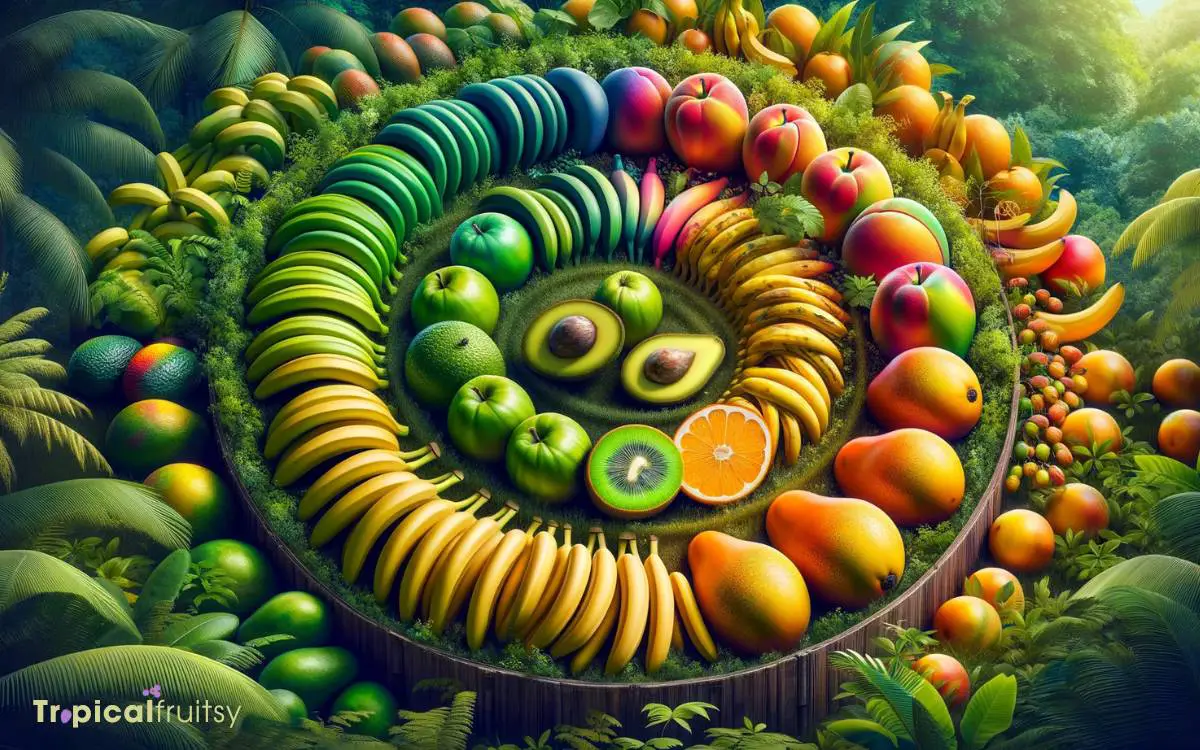
The ripening process of fruits in tropical regions is significantly influenced by the warm and humid climate, which accelerates the conversion of starches into sugars.
This biochemical transformation is mediated by a cadre of enzymes, such as amylases, which break down complex carbohydrates into simpler, sweet-tasting sugars like glucose and fructose.
The heightened temperatures facilitate enzymatic activity, thereby catalyzing the degradation of starches at a more rapid pace compared to temperate zones.
In addition, the elevated levels of ethylene, a gaseous hormone produced by the fruits, trigger and hasten ripening.
This hormonal surge is a response to the climatic conditions, ensuring that the fruit quickly reaches its peak sweetness and nutritional value, which is essential for attracting frugivores for seed dispersal.
Fruit Diversity and Ecology
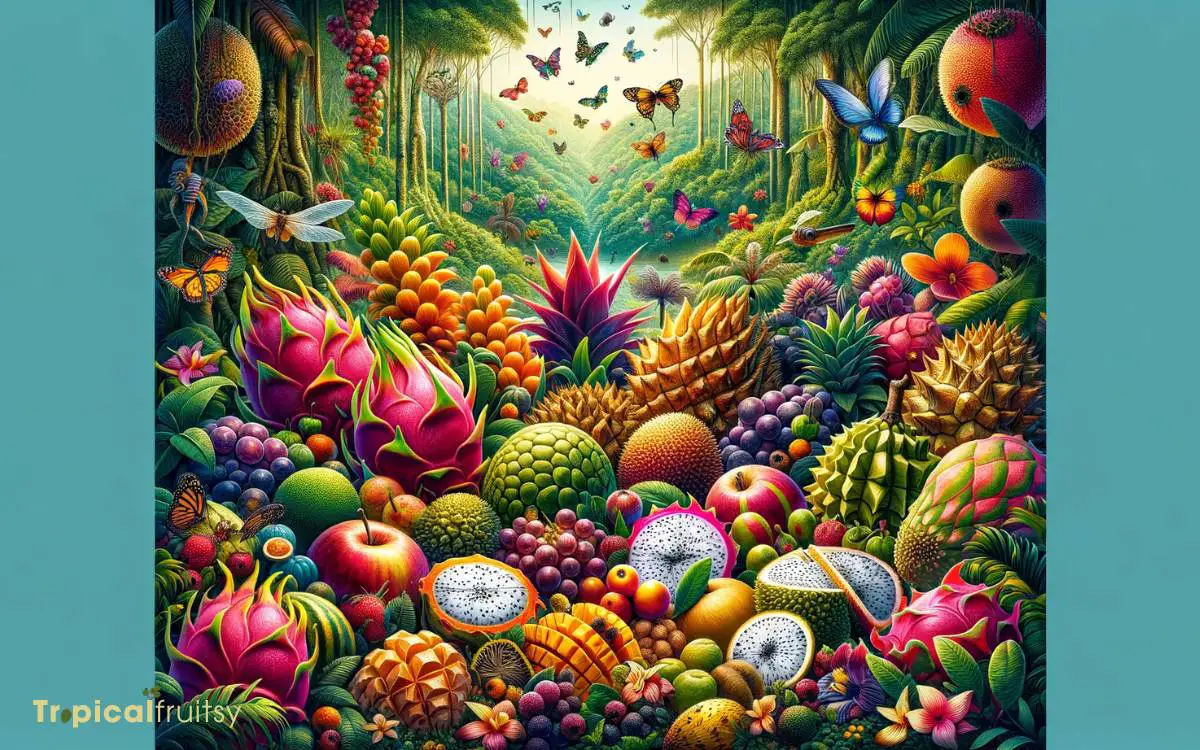
The ecological diversity of tropical regions has fostered a wide array of fruit adaptations, each evolved to ensure successful reproduction and dispersal within specific niches.
Variations in fruit sweetness can often be traced to distinct pollination strategies, with some species optimizing their sugar content to attract certain pollinators.
Moreover, the physical and climatic characteristics of a habitat directly influence fruit characteristics, including flavor profiles, to suit the preferences of local frugivores.
Ecological Adaptations
Ecological adaptations have led to the development of a diverse array of sweet fruits in tropical regions, each evolved to attract specific pollinators and seed dispersers.
The intricate relationship between fruit characteristics and ecological roles underpins the evolution of this diversity.
Seed Dispersal Mechanisms:
- Attracting animals with sweet fruits, which are then dispersed through ingestion and excretion.
- Adapting to wind patterns for seed spread, influencing fruit shape and buoyancy.
- Developing mechanisms like explosive dehiscence to distribute seeds over distances.
Pollinator Attraction:
- Evolving vibrant colors and aromatic compounds to lure specific pollinators.
- Synchronizing fruit maturation with pollinator activity patterns.
Survival Strategies:
- Developing thick skins or rinds to protect against predators.
- Ripening in stages to ensure extended seed dispersal opportunities.
Understanding these adaptations sets the stage to explore the complexities of tropical fruit pollination strategies, the focus of our next discussion.
Pollination Strategies
Pollination strategies in tropical fruits encompass a remarkable variety of approaches, each finely tuned to the ecological niche and the behavior of specific pollinators.
Tropical ecosystems possess a high degree of biodiversity, which is mirrored in the pollination mechanisms that plants have evolved.
These range from reliance on wind and water to complex interactions with animals such as birds, bats, insects, and even mammals.
The mutualistic relationships between fruit-bearing plants and their pollinators are fundamental to the reproductive success of the species and the perpetuation of genetic diversity.
| Pollinator Type | Examples |
|---|---|
| Insects | Bees, butterflies, beetles |
| Birds | Hummingbirds, sunbirds |
| Mammals | Bats, monkeys |
| Abiotic | Wind, water |
The evolutionary interplay between these organisms has led to the rich tapestry of fruit characteristics observed within tropical regions.
Habitat Influence
Many tropical habitats are characterized by intense competition for pollinator attention, which has driven the evolution of a diverse array of sweet fruits to attract various animal species.
This ecological interaction has consequences for fruit diversity:
Selective Pressures:
- Pollinator Preference: Species develop sweeter fruits to satisfy specific pollinators.
- Predator Avoidance: Some fruits evolve to deter non-pollinator species.
- Dispersal Methods: Fruit sweetness can influence the distance seeds are spread.
Ecological Niches:
- Specialization: Plants may adapt their fruit’s sweetness to attract a particular animal’s palate.
- Symbiotic Relationships: Certain fruits and their primary dispersers evolve in tandem.
Species Interaction:
- Competition: Plants may enhance sweetness to outcompete others for animal attention.
- Mutualism: Fruits provide nourishment, while animals facilitate pollination and seed dispersal.
These factors, integral to the habitat’s influence on fruit development, set the stage for how climate can further shape these sweet tropical offerings.
Climate Impact on Fruit Development

Temperature and sunlight, intrinsic elements of tropical climates, play pivotal roles in the development of the high sugar content in tropical fruits.
Elevated temperatures facilitate a higher rate of photosynthesis, the process by which plants convert light energy into chemical energy. In the tropics, consistent warmth accelerates metabolic processes, leading to rapid growth and fruit maturation.
The abundant sunlight provides the energy necessary for fruiting plants to synthesize large amounts of sugars, particularly sucrose, glucose, and fructose, which are fundamental components of fruit sweetness.
Consequently, the intense solar exposure in these regions results in the accumulation of higher sugar concentrations within the fruit’s tissues.
Understanding this climatic effect sets the stage to explore how factors like pollination further influence the sweetness of tropical fruits.
Pollination and Fruit Sweetness
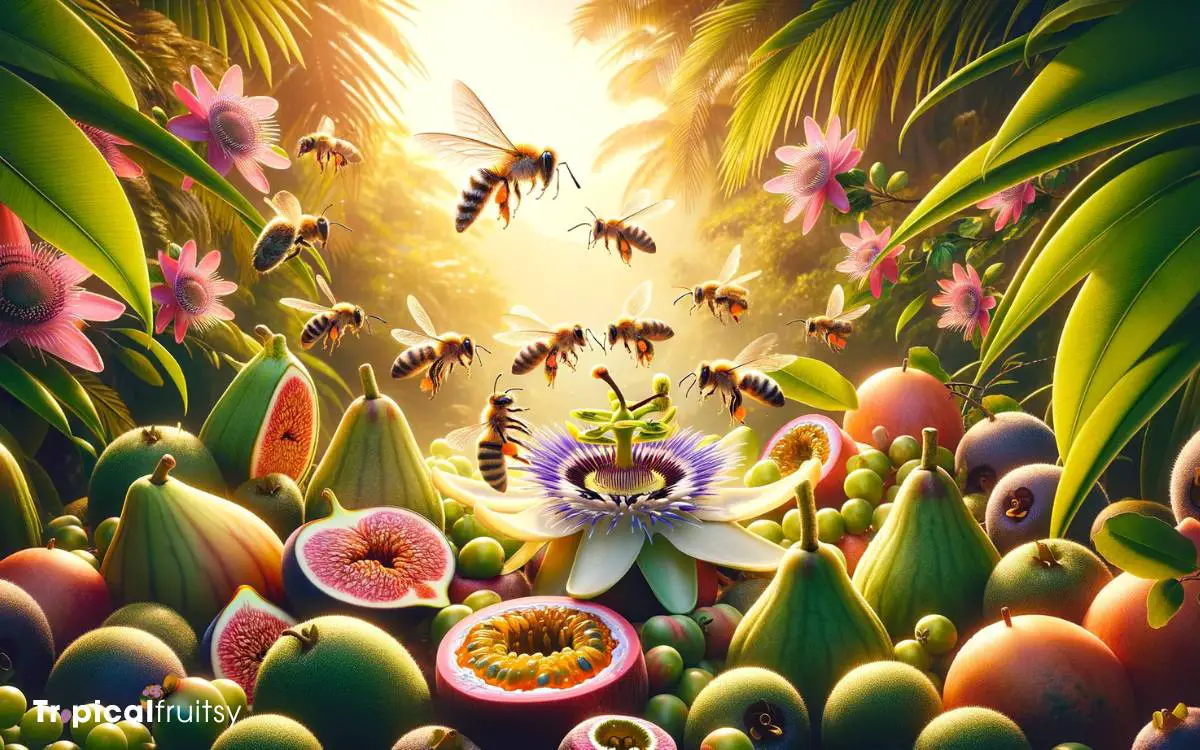
Building on the influence of climate, pollination plays a crucial role in the development of sweetness in tropical fruits by facilitating the transfer of pollen necessary for fruit production and the potential enhancement of sugar concentrations.
The process involves a diverse array of pollinators that influence fruit characteristics:
Pollinators:
- Bees: Promote cross-pollination, increasing genetic diversity and fruit quality.
- Bats: Prefer sweeter nectar, possibly driving plants to produce sweeter fruits.
- Birds: Like hummingbirds, may favor plants with high sugar content nectar, influencing fruit sweetness.
Scientific evidence suggests that plants with effective pollination strategies often yield fruit with higher sugar content, as robust pollination can lead to more abundant and nutritionally superior fruits.
This naturally selected sweetness is further molded by human cultivation practices, which we will explore in the following section.
What Makes Tropical Fruits So Sweet, and What Fruits are Found at Tropical Fruit World?
Tropical fruits are known for their sweetness due to the warm climate and abundance of sunlight which helps in the production of natural sugars. At Tropical Fruit World, located in Australia, visitors can explore tropical fruit world location and find a variety of fruits like mangoes, bananas, avocados, and papayas.
Human Cultivation Practices
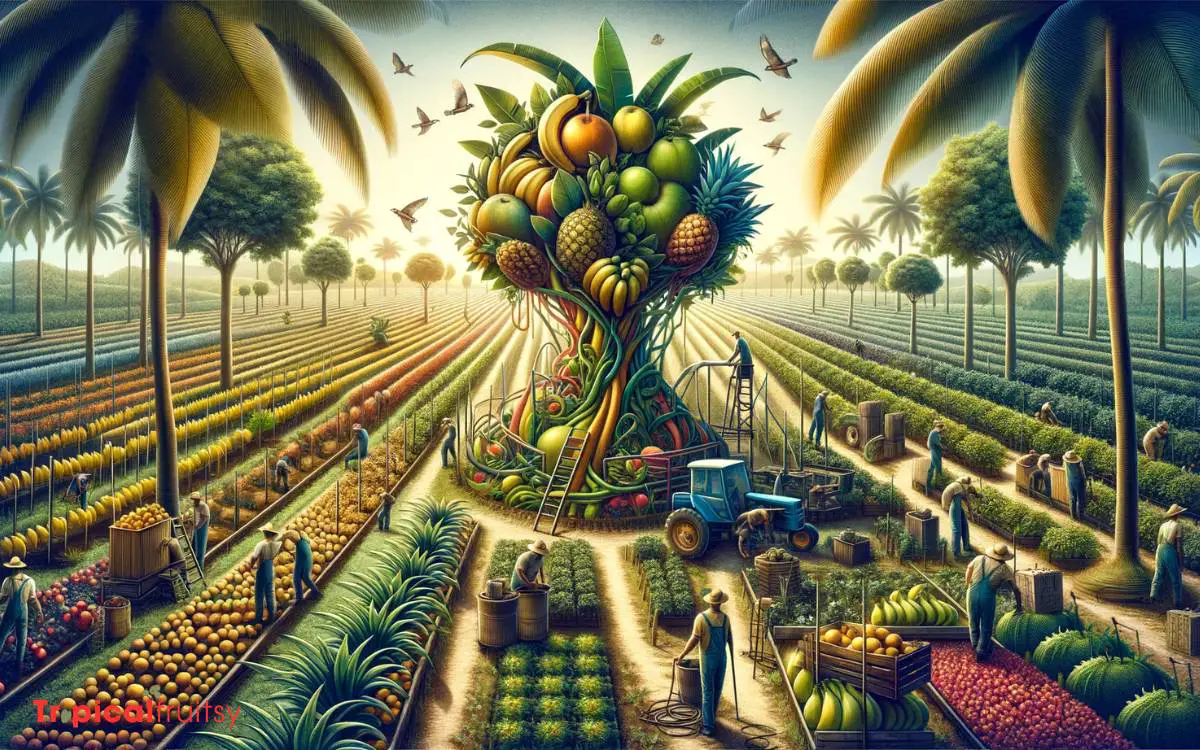
While natural processes like pollination contribute to the inherent sweetness of tropical fruits, human cultivation practices have significantly refined and amplified these sugary characteristics through selective breeding and agricultural techniques.
Over generations, cultivators have chosen specimens with desirable sweetness levels for propagation, gradually enhancing the sugar content in the progeny.
This form of artificial selection parallels natural evolution but operates under human preferences rather than environmental pressures.
Advanced horticultural methods, including grafting, have also been employed to propagate favorable traits rapidly and consistently.
Furthermore, optimized irrigation, fertilization, and pest control contribute to the health of the fruit-bearing plants, thereby improving fruit quality and sweetness.
These deliberate modifications and care protocols are pivotal in the development of the intensely sweet tropical fruit varieties available today.
Conclusion
The opulent sweetness of tropical fruits, a lure for seed dispersers, stands in stark contrast to the ecological challenges they endure.
Despite the relentless heat and fierce competition, these fruits have evolved to become treasure troves of sugars, paradoxically using their own vulnerability to ensure survival.
Through the lens of irony, their very delicacy has cultivated resilience, ensuring that even in the face of climatic adversity, the sweetest triumphs emerge.

